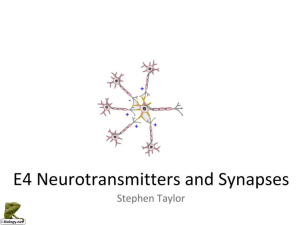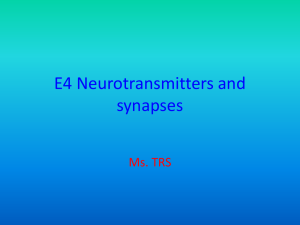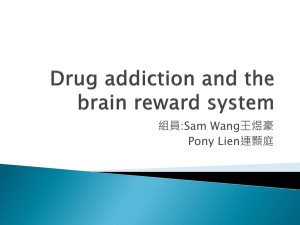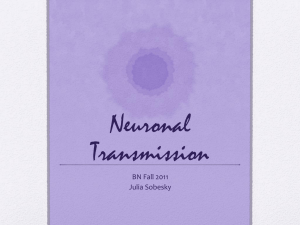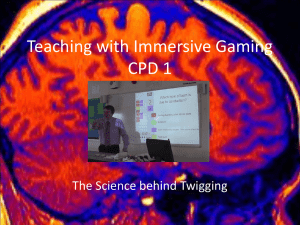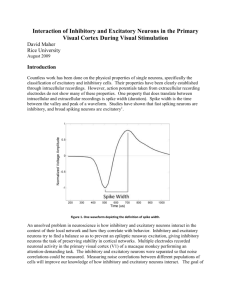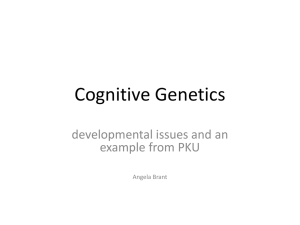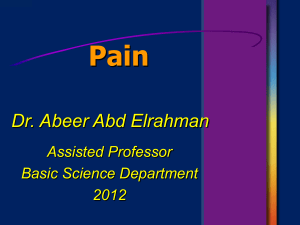Explain
advertisement
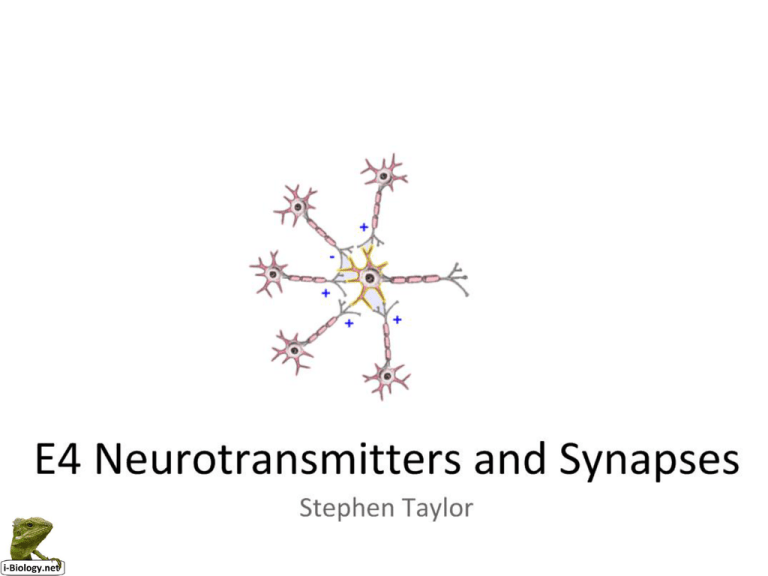
Assessment Statements Obj. E4.1 State that some neurotransmitters excite postsynaptic transmission and others inhibit postsynaptic transmission. 1 E4.2 Explain how decision-making in the CNS can result from the interaction between the activities excitatory and inhibitory presynapatic neurons at synapses. 3 E4.3 Explain how psychoactive drugs affect the brain and personality by either increasing or decreasing postsynaptic transmission. 3 E4.4 List three examples of excitatory and three examples of inhibitory psychoactive drugs. • Excitatory: nicotine, cocaine, amphetamines • Inhibitory: benzodiazepines, alcohol, tetrahydrocannabinol (THC) 1 E4.5 Explain the effects of cocaine and THC in terms of their action at synapses in the brain. 3 E4.6 Discuss the causes of addiction, including genetic predisposition, social factors and dopamine secretion. 3 Be sure you have a solid understanding of action potentials and synapses as you work through this subtopic. Command terms: http://i-biology.net/ibdpbio/command-terms/ Assessment statements from: Online IB Biology Subject Guide Communication via Synapses Synapses are a fundamental part of neural pathways as they regulate decision-making in terms of exciting or inhibiting the postsynaptic neurons. Review: • Action potentials (AP) reach terminal bud of the pre-synaptic neuron. • Neurotransmitters (NT), chemical messengers, diffuse across the synapse to bind with receptors on the postsynaptic membrane. http://www.youtube.com/watch?v=LT3VKAr4roo Work through this tutorial: Neurotransmitters are: • Excitatory, which means they excite the post-synaptic neuron (contributing to depolarisation and propagation of the AP. OR: • Inhibitory, hyperpolarising the postsynaptic neuron and preventing AP. http://learn.genetics.utah.edu/content/addiction/reward/neurontalk.html Neurotransmitters can be excitatory or inhibitory Neurotransmitters (NT) are proteins • diffuse across the synaptic cleft • bind with a receptor on the post-synaptic neuron. Whether or not the post-synaptic neuron propagates the action potential depends on: • Which NT diffuses across • Which receptors they bind to • Which ions flow in/out of the post-synaptic neuron • Whether or not depolarisation reaches threshold Excitatory NTs cause depolarisation • e.g. ACh, dopamine http://is.gd/Jellinek 0mv depolarisation threshold -70mv • • NT binds, Na+ channels open, Na+ rushes in Membrane potential depolarises, AP propagated Inhibitory NTs cause hyperpolarisation • e.g. GABA, dopamine (on different pathways) resting hyperpolarisation time • • • • • NT binds to receptor K+ channels open, K+ rushes out OR Cl- channels open, Cl- rushes in Membrane potential become more negative Action potential is prevented from propagating http://www.youtube.com/watch?v=-pfG6yHAQ5U This is a useful example of an inhibitory neurotransmitter. Decision-making in the Central Nervous System (CNS) The axons of many pre-synaptic neurons feed into the dendrites of one post-synaptic neurons via synapses. The ‘decision’ whether or not to propagate the action potential along the axon of the post-synaptic neuron takes place synapse in a region of the cell body called the axon hillock. axon This is achieved through summation of the incoming impulses. If the total axon hillock impulse reaches threshold, the post-synaptic neuron depolarises and the action potential is propagated. If the sum does not reach threshold, the AP is not propagated. There are two main methods of summation: temporal and spatial. Diagram adapted from: http://hsc.uwe.ac.uk/synapses_neuro/summation.htm Decision-making in the Central Nervous System (CNS) Test out temporal and spatial summation: Temporal summation • Action potentials arrive in rapid succession • Depolarisation in the axon hillock is summative • If it reaches threshold before repolarisation, the AP is propagated. Spatial summation • Action potentials arrive simultaneously from multiple sources • Some neurotransmitters are excitatory (increasing depolarisation) • Other NTs are inhibitory (hyperpolarising). • Summation in the axon hillock is summative. • If it reaches threshold the AP is propagated. Diagram adapted from: http://hsc.uwe.ac.uk/synapses_neuro/summation.htm How do psychoactive drugs affect the brain? Before thinking about how drugs affect the synapses, be sure you understand how they work and are reset. • Some NTs have a normal excitatory function • Other NTs have a normal inhibitory function In general, psychoactive drugs can: 1. Increase or decrease the release of NTs (e.g. THC – cannabis) 2. Breakdown re-uptake proteins which are responsible for returned used components of NTs to the pre-synaptic neuron (ready to use again) 3. Block re-uptake proteins (e.g.cocaine) 4. Mimic or block NTs, binding to the receptors on post-synaptic membranes 5. Inhibit production of new NTs Work through the excellent animations and explanations from http://www.jellinek.eu/ http://www.jellinek.eu/brain/index.html?KeepThis=true&TB_iframe=true&height=588&width=672 Excitatory drugs increase post-synaptic transmission Examples: • Nicotine, amphetamines, cocaine What is the effect of cocaine? Normal: • Dopamine acts as excitatory NT • Dopamine is re-uptaken by pumps on the presynaptic membrane. With Cocaine: • Cocaine blocks re-uptake pumps • Dopamine remains in synaptic cleft • More dopamine continues to be released • Summative increase in post-synaptic transmission Effects on mood: • Dopamine is involved in reward pathways, enhancing feelings of pleasure • Longer-lasting feelings as dopamine is not reuptaken Effects on behaviour: • feelings of euphoria • increased energy and alertness • highly addictive • association with depression as body reduces production of own dopamine over time http://is.gd/Jellinek Inhibitory drugs decrease post-synaptic transmission Examples: • Alcohol, benzodiazapines, THC What is the effect of tetrahydrocannibol (THC)? Normal: • Dopamine release is moderated (inhibited) by GABA With THC: • THC mimics cannabinoids and inhibits GABA release by binding to cannabinoid receptors • GABA cannot inhibit dopamine release • More dopamine is released Effects on mood: • Dopamine is involved in reward pathways, enhancing feelings of pleasure • Not as extreme release of dopamine as with cocaine, but still higher than normal Effects on behaviour: • intoxication • hunger • memory impairment • potential dependency http://is.gd/Jellinek http://thebrain.mcgill.ca/intermediaire.php http://outreach.mcb.harvard.edu/animations/synapse.swf A scale of harm for drugs Which dots represent: • tobacco? • alcohol? • heroin? • cocaine? • THC/ cannabis? • ecstasy? Drag the red dot to point you think represents alcohol. How can drugs cause physical harm? How can drug use lead to addiction (dependency)? What factors contribute to development of addiction? ActivePrompt link: http://activeprompt.herokuapp.com/SQSNK or http://is.gd/drugscaleprompt http://activeprompt.herokuapp.com/TYYBH http://www.youtube.com/watch?v=bCChf2WHNE4 @IBiologyStephen Please consider a donation to charity via Biology4Good. Click here for more information about Biology4Good charity donations. This is a Creative Commons presentation. It may be linked and embedded but not sold or re-hosted.
